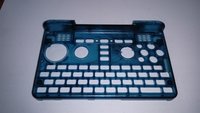This sounds like not a good idea at all. Nobody will miss the 1.5mm more heatsink (can you quantify the difference this makes?) vs adding yet another supplier and fail mode, extra cost, extra risk...
Not necessarily. The heatsinks I bought look like they were actually cut from a way wider "heatsink-stick" (no idea how to call that properly)
So like they produced a 1m x 15mm long heatsink and then cut it into small 15x15mm heatsinks. Or maybe the even produced a 1m x 1m heatsink and cut this into the small ones. You can clearly see that, as the fins on the heatsink aren't always fully symmetrical, some are cut in half

If we find a company that produces them, it would be easy to cut them simple 1.5mm longer

[doublepost=1554558814,1554556922][/doublepost]
Hi everybody,
I don't know if it's useful, but in France it's a specialist for adhesive cutting, they could make a tool for special form, just send a plan and a quantity
www.adezif.com
Let me know if you want I can call them. I have a bit of time since June, so why not if I could help this amazing pyra project ? I guess you already know that in France it's always weird especially in industrial stuffs

Not hesitate contact me if it can help...
Thanks a lot!
This looks like it's what I'm talking about:
https://www.adezif.com/adhesive-tape-die-cutting-possibilities
I'll discuss this with the case company first, maybe they have some other idea.
Sealing: @EvilDragon if You could please post here a .dxf (or any vector graphic, it's no big deal to convert them) to describe the shape of the sealing, or at least tell us the inner and outer size of a rectangular approximation, then starting monday I'd be happy to volunteer and ask around moderate-sized print houses, ad agencies and metal shops about cutting it mechanically, by laser, or stamping it out.
I need to create that first, as we still need to think aobut the best way to do this.
Heatsinks: if You have a design or a general idea and +/- dimensions, then why not share it? Forum users could show it around and who knows, maybe there is a cost- and time- effective source somewhere in Europe.
Here, particularly close to the German border, a lot of small and medium companies live off exporting such components like Pyra's and logos or heatsinks to Germany, I sure can ask around here and others can ask at their place.
I used 13x12mm with 5mm height ones.
These seem to be pretty standard. The ones I got are these:
Amazon product ASIN B01EZQIV2S
As you can see, it certainly looks like it was one large heatsink that was cut into pieces at one side. That's why the fins are rounded on one side while they look cut on the other side.
But I'll check for the perfect size.
Logos: Do we have all the logos already or just some sample ones? I am freshly unemployed and taking it easy this week on job hunting still, so for me it's no problem to send a dozen inquiries here and there or even drive around and ask around personally this week.
We have a company already, just seems we need to provide them with the proper material (aluminium with self-adhesive).
That's already being worked on

ED posted some pictures of it on the last news thread, such as
He attached an alleged dwg file from which you can apparently get dimensions.
Edit: I managed to install librecad and view it in that. Apparently the width is from -22.87 to +41.18 so a total of 63.1mm wide or thereabouts.
The DWG is in mm size, which you need to provide to the software when importing.
That is the design for MOVING the heat away from the CPU to the heatsink.
It's 0.2mm thick, it's this material:
https://www.digikey.com/products/en?keywords=1168-2068-ND
The company is from Asia, so in case you know a company with a similar product that can do custom die cuts here in Europe, you can also let me know

How much we talking here ED?
Quick guess: Approx. 150k - 200k.
[doublepost=1554559083][/doublepost]Quick update from the case company:
They played around with some materials today, but it looks like the discolorizations and shrinks come from the mold surface and can only be covered a bit depending on the material being used.
Transparent works better (what's why you don't see anything like it with the transparent cases), and semi-transparent works okay, but still has some issues:

That's a semi-transparent oceanblue material.
To fix this, we'd need the copper anodes (which aren't usually provided with the molds, as finished molds shouldn't have these issues anymore).
We're trying next week to get the copper anodes from the previous company as well, as then we could properly fix it.
At the same time, the new company is also looking for different workarounds to solve that issue!
We're at it!


